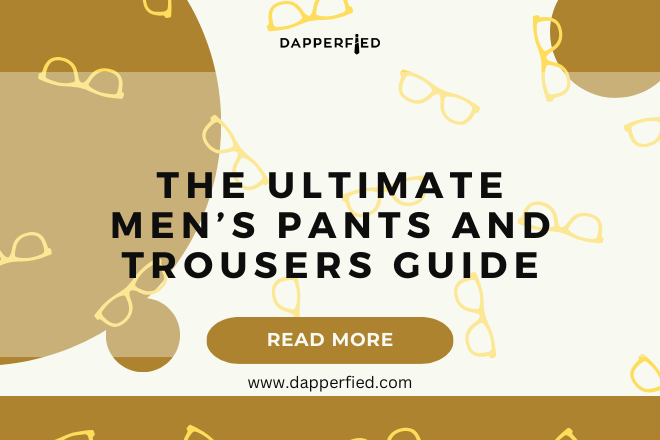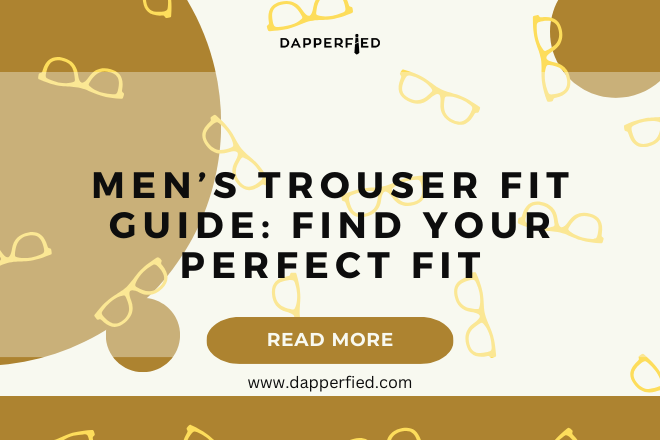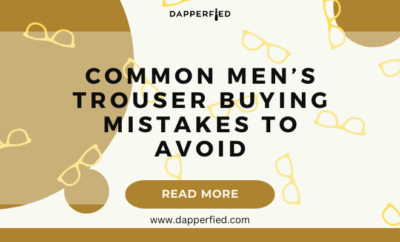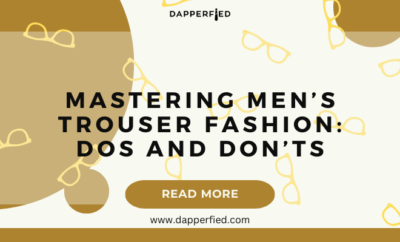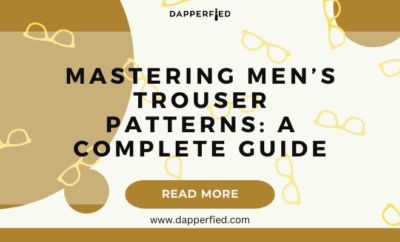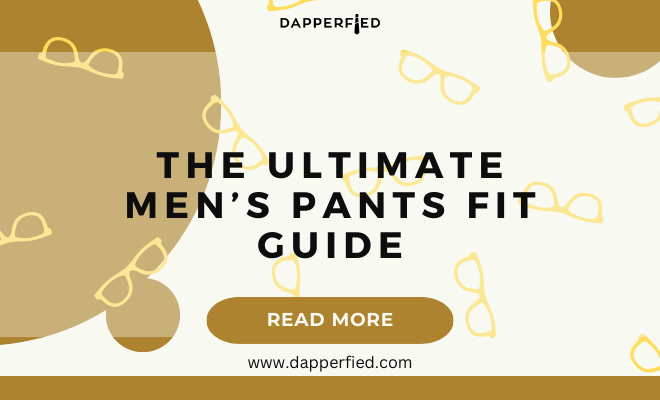
Men's Style
The Ultimate Men’s Pants Fit Guide
When it comes to men’s pants, there are several different fits to choose from, each offering a unique look and feel. The most common pant fits include slim fit, straight fit, relaxed fit, and bootcut. Slim fit pants are designed to hug the body closely, providing a sleek and modern silhouette. Straight fit pants offer a more traditional cut, with a straight leg that provides a classic and timeless look. Relaxed fit pants are roomier in the seat and thigh, offering a more comfortable and casual feel. Bootcut pants feature a slight flare at the bottom, making them ideal for wearing with boots or for a more relaxed, laid-back look.
In addition to these standard fits, there are also variations within each category, such as skinny fit, tapered fit, and athletic fit. Skinny fit pants are even more form-fitting than slim fit, while tapered fit pants have a narrower leg opening. Athletic fit pants are designed for men with larger thighs and offer a more generous cut in the seat and thigh area. Understanding the differences between these fits is essential for finding the perfect pair of pants that not only look great but also feel comfortable and suit your personal style.
Key Takeaways
- Different pant fits include slim, straight, relaxed, and bootcut, each offering a unique silhouette and style.
- Finding the right waist and inseam measurements is crucial for a comfortable and flattering fit.
- Pant rise, whether low, mid, or high, can significantly impact the overall fit and comfort of the pants.
- Choosing the best fabric for your lifestyle, such as denim, cotton, or wool, can enhance the durability and comfort of your pants.
- Tailoring and alterations can help achieve the perfect fit, ensuring that the pants flatter your body shape and proportions.
Finding the Right Waist and Inseam Measurements
One of the most important aspects of finding the right pair of pants is ensuring that they fit properly in the waist and inseam. The waist measurement is taken around the natural waistline, which is typically located just above the belly button. It’s important to measure the waist accurately to ensure a comfortable fit that doesn’t feel too tight or too loose. Inseam measurement, on the other hand, is taken from the crotch to the bottom of the leg, and it determines the length of the pants. Getting the inseam measurement right is crucial for avoiding pants that are too long or too short.
When shopping for pants, it’s essential to pay attention to the sizing charts provided by the brand or retailer to find the right waist and inseam measurements. Additionally, trying on different sizes and styles can help determine the best fit for your body type. Keep in mind that different brands may have slightly different sizing, so it’s important to be flexible and open to trying on various sizes to find the perfect fit.
Deciphering Pant Rise and How It Affects Fit
Pant rise refers to the distance between the crotch and the waistband of the pants and plays a significant role in how the pants fit and feel. There are three main types of pant rise: low rise, mid-rise, and high rise. Low rise pants sit below the natural waistline and are often associated with a more modern and youthful look. Mid-rise pants sit at or just below the natural waistline and offer a classic and versatile fit that works well for most body types. High rise pants sit above the natural waistline and provide a more traditional and formal look.
Understanding how pant rise affects fit is crucial for finding pants that are comfortable and flattering. For example, men with longer torsos may find that high rise pants provide a better fit, while those with shorter torsos may prefer mid-rise or low rise options. Additionally, pant rise can also impact the overall style of the pants, so it’s important to consider how it complements your personal style and wardrobe.
Choosing the Best Fabric for Your Lifestyle
| Fabric Type | Characteristics | Best for |
|---|---|---|
| Cotton | Soft, breathable, easy to care for | Everyday wear, casual clothing |
| Wool | Warm, insulating, durable | Cold weather clothing, outerwear |
| Polyester | Durable, wrinkle-resistant, quick-drying | Active wear, travel clothing |
| Silk | Luxurious, smooth, lightweight | Formal wear, evening attire |
The fabric of a pair of pants can significantly impact its comfort, durability, and overall appearance. When choosing pants, it’s essential to consider the fabric and how it will suit your lifestyle and needs. Some common pant fabrics include cotton, wool, denim, polyester, and blends of these materials. Cotton is a popular choice for its breathability and versatility, making it suitable for both casual and formal wear. Wool is known for its warmth and durability, making it an excellent choice for dress pants or colder climates. Denim is a rugged and durable fabric that is often associated with casual wear, while polyester offers wrinkle resistance and easy care.
Consider your daily activities and climate when choosing the fabric for your pants. For example, if you have an active lifestyle, you may prefer pants made from moisture-wicking materials that offer stretch for ease of movement. On the other hand, if you work in a professional setting, you may opt for dress pants made from wool or wool blends for a polished look. Understanding the different fabric options available can help you make an informed decision when shopping for pants that suit your lifestyle.
Tailoring and Alterations for the Perfect Fit
While finding pants that fit well off the rack can be challenging, tailoring and alterations can help achieve the perfect fit. Common alterations for men’s pants include hemming to adjust the length, taking in or letting out the waistband for a better fit around the waist, tapering the legs for a slimmer silhouette, and adjusting the rise for improved comfort. Tailoring can transform a pair of pants from good to great by ensuring that they fit your body perfectly and flatter your figure.
When considering alterations, it’s essential to work with a skilled tailor who understands how to achieve the desired fit without compromising the overall look of the pants. Additionally, it’s important to communicate your preferences clearly to ensure that the alterations meet your expectations. While tailoring may involve additional cost and time, the result is well worth it when you have a pair of pants that fits like a glove and makes you look and feel confident.
Styling Tips for Different Pant Fits

Once you’ve found the perfect pair of pants that fit well and suit your style, it’s essential to know how to style them for different occasions. Slim fit pants can be dressed up with a tailored blazer and dress shoes for a sophisticated look or dressed down with a casual shirt and sneakers for a more relaxed vibe. Straight fit pants are versatile and can be paired with anything from a button-up shirt for a polished look to a graphic tee for a casual ensemble. Relaxed fit pants are ideal for laid-back occasions and can be styled with a loose-fitting shirt or sweater for maximum comfort.
When it comes to bootcut pants, it’s important to consider footwear when styling them. These pants are designed to accommodate boots, so they pair well with chunky boots or cowboy boots for a rugged aesthetic. Additionally, paying attention to color coordination and proportions can elevate any outfit featuring different pant fits. Understanding how to style each pant fit can help you create diverse looks that suit various occasions and reflect your personal style.
Common Mistakes to Avoid When Buying Men’s Pants
When shopping for men’s pants, there are several common mistakes to avoid to ensure that you find the best-fitting and most flattering options. One common mistake is overlooking proper measurements before making a purchase. It’s essential to take accurate waist and inseam measurements to find pants that fit well from the start. Another mistake is ignoring pant rise when considering fit. Understanding how pant rise affects comfort and style is crucial for finding pants that suit your body type and personal preferences.
Additionally, overlooking fabric quality can lead to disappointment in terms of comfort and durability. It’s important to consider the fabric of the pants and how it will suit your lifestyle before making a purchase. Finally, neglecting alterations can result in settling for ill-fitting pants that don’t do justice to your figure. Investing in tailoring and alterations can make a world of difference in achieving the perfect fit. By avoiding these common mistakes when buying men’s pants, you can ensure that you find options that not only look great but also feel comfortable and suit your lifestyle.

If you’re looking for the perfect pair of pants to go with your new suit, be sure to check out our article on the latest clothes trends for men. From slim fit to straight leg, this guide will help you find the right fit for your body type. https://www.dapperfied.com/latest-clothes-trends-men-guide/
FAQs
What are the different types of men’s pants fits?
There are several different types of men’s pants fits, including slim fit, straight fit, relaxed fit, and athletic fit. Each fit is designed to cater to different body types and style preferences.
How do I know which pants fit is right for me?
The best way to determine which pants fit is right for you is to consider your body type and personal style. Slim fit pants are ideal for those with a slender build, while relaxed fit pants are better suited for those who prefer a looser, more comfortable fit.
What is the difference between slim fit and straight fit pants?
Slim fit pants are designed to be more form-fitting and tapered, while straight fit pants have a more uniform width from the thigh to the ankle. Slim fit pants are ideal for those who prefer a more tailored look, while straight fit pants offer a more classic, versatile style.
Can I alter the fit of my pants?
Yes, it is possible to alter the fit of your pants through tailoring. A skilled tailor can adjust the waist, inseam, and leg width to achieve a more customized fit that suits your body shape and style preferences.
What should I consider when buying men’s pants?
When buying men’s pants, it’s important to consider the fit, fabric, and style. Pay attention to the waist and inseam measurements to ensure a proper fit, and choose a fabric and style that aligns with your personal preferences and lifestyle.

